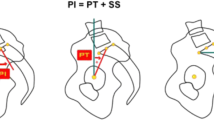Abstract
Introduction
The aim of this prospective study was to assess the sagittal alignment of the spine and pelvis before and after surgical treatment of isthmic spondylolisthesis with flat sacrum. At the same time, the functional outcome was analyzed and correlation examined.
Materials and methods
This study comprises analysis of 30 subjects (mean age 43 years) with isthmic spondylolisthesis and an average follow-up of 2.5 years after posterior spinal fusion. Radiological spinopelvic parameters were measured and functional evaluation was made using the Oswestry Disability Index.
Results
Significant improvement toward more normal values for PT and SS in relation to PI was observed after surgery. Pelvic incidence was unaffected by surgery. Correction of the spinosacral angle shows that the anterior tilt with anterior sagittal imbalance due to spondylolisthesis may be corrected by reduction and fusion of the slipped level. Functional outcome was satisfactory with a statistically significant difference between preoperative values and final follow-up values. The sub-group of patients with insufficient restoration of sagittal balance parameters had less good outcomes than the others.
Discussion and Conclusion
Surgical management of low- and mid-grade isthmic spondylolisthesis showed good clinical outcome with restoration of correct values for the pelvic position-dependent parameters, i.e., pelvis tilt, sacral slope, C7 plumb line position and SSA.




Similar content being viewed by others
References
Barrey C, Jund J, Perrin G, Roussouly P (2007) Spinopelvic alignment of patients with degenerative spondylolisthesis. Neurosurgery 61:981–986
Carreon LY, Glassman SD, Howard J (2008) Fusion and nonsurgical treatment for symptomatic lumbar degenerative disease: a systematic review of Oswestry Disability Index and MOS Short Form-36 outcomes. Spine J 8:747–755
Debarge R, Demey G, Roussouly P (2009) Radiological analysis of ankylosing spondylitis patients with severe kyphosis before and after pedicle subtraction osteotomy. Eur Spine J 19:65–70
Dubousset J (1997) Treatment of spondylolysis and spondylolisthesis in children and adolescents. Clin Orthop Relat Res 337:77–85
Goyal N, Wimberley DW, Hyatt A, Zeiller S, Vaccaro AR, Hilibrand AS, Albert TJ (2009) Radiographic and clinical outcomes after instrumented reduction and transforaminal lumbar interbody fusion of mid and high-grade isthmic spondylolisthesis. J Spinal Disord Tech 22:321–327
Hresko MT, Hirschfeld R, Buerk AA, Zurakowski D (2009) The effect of reduction and instrumentation of spondylolisthesis on spinopelvic sagittal alignment. J Pediatr Orthop 29:157–162
Hresko MT, Labelle H, Roussouly P, Berthonnaud E (2007) Classification of high-grade spondylolistheses based on pelvic version and spine balance: possible rationale for reduction. Spine 32:2208–2213
Kwon BK, Hilibrand AS, Malloy K, Savas PE, Silva MT, Albert TJ, Vaccaro AR (2005) A critical analysis of the literature regarding surgical approach and outcome for adult low-grade isthmic spondylolisthesis. J Spinal Disord Tech 18(Suppl):S30–S40
Labelle H, Roussouly P, Berthonnaud E, Dimnet J, O’Brien M (2005) The importance of spino-pelvic balance in L5–s1 developmental spondylolisthesis: a review of pertinent radiologic measurements. Spine 30(Suppl):S27–S34
Labelle H, Roussouly P, Chopin D, Berthonnaud E, Hresko T, O’Brien M (2008) Spino-pelvic alignment after surgical correction for developmental spondylolisthesis. Eur Spine J 17:1170–1176
Lazennec JY et al (2000) Sagittal alignment in lumbosacral fusion: relations between radiological parameters and pain. Eur Spine J 9:47–55
Legaye J, Duval-Beaupere G, Hecquet J, Marty C (1998) Pelvic incidence: a fundamental pelvic parameter for three-dimensional regulation of spinal sagittal curves. Eur Spine J 7:99–103
Molinari RW, Bridwell KH, Lenke LG, Baldus C (2002) Anterior column support in surgery for high-grade, isthmic spondylolisthesis. Clin Orthop Relat Res 394:109–120
Moller H, Hedlund R (2000) Surgery versus conservative management in adult isthmic spondylolisthesis–a prospective randomized study: part 1. Spine 25:1711–1715
Roussouly P, Gollogly S, Berthonnaud E, Dimnet J (2005) Classification of the normal variation in the sagittal alignment of the human lumbar spine and pelvis in the standing position. Spine 30:346–353
Schwab F, Lafage V, Patel A, Farcy JP (2009) Sagittal plane considerations and the pelvis in the adult patient. Spine 34:1828–1833
Conflict of interest
None.
Author information
Authors and Affiliations
Corresponding author
Rights and permissions
About this article
Cite this article
Bourghli, A., Aunoble, S., Reebye, O. et al. Correlation of clinical outcome and spinopelvic sagittal alignment after surgical treatment of low-grade isthmic spondylolisthesis. Eur Spine J 20 (Suppl 5), 663 (2011). https://doi.org/10.1007/s00586-011-1934-z
Received:
Accepted:
Published:
DOI: https://doi.org/10.1007/s00586-011-1934-z




